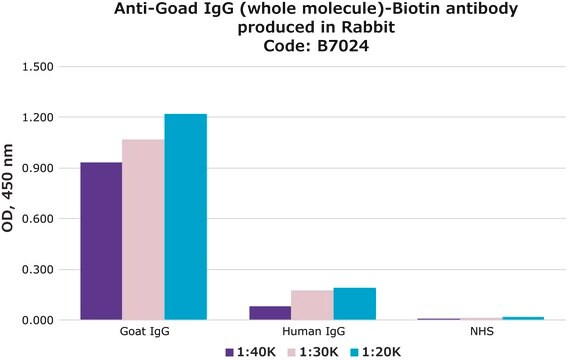B8061
N-Butyl-N-(4-hydroxybutyl)nitrosamine
ISOPAC®, ≥90% (GC)
Synonim(y):
BBN, N-Butyl-N-butan-4-ol-nitrosamine, N-Butyl-N-nitroso-4-aminobutanol, OH-BBN
Zaloguj sięWyświetlanie cen organizacyjnych i kontraktowych
About This Item
Wzór empiryczny (zapis Hilla):
C8H18N2O2
Numer CAS:
Masa cząsteczkowa:
174.24
Kod UNSPSC:
12352116
NACRES:
NA.25
Polecane produkty
Poziom jakości
Próba
≥90% (GC)
Formularz
liquid
temp. przechowywania
2-8°C
InChI
1S/C8H18N2O2/c1-2-3-6-10(9-12)7-4-5-8-11/h11H,2-8H2,1H3
Klucz InChI
DIKPQFXYECAYPC-UHFFFAOYSA-N
Powiązane kategorie
Zastosowanie
N-Butyl-N-(4-hydroxybutyl)nitrosamine (BBN), a carcinogen, is used to induce histiologically relevant aggressive urinary bladder cancer in animal models.
Działania biochem./fizjol.
Carcinogen used to induce urinary bladder cancer in animal models. The result of exposure is histologically comparable to human urinary bladder tumorigenesis. Used in chemopreventative studies.
Opakowanie
Packaged in a 100 mL serum bottle with butyl rubber stopper and aluminum tear seal.
Przestroga
Injecting any compatible solvent permits preparation of any desired strength solution without exposure.
Rekonstytucja
Dissolving the contents in 100 mL of solvent yields a 1% solution.
Informacje prawne
Isopac is a registered trademark of Merck KGaA, Darmstadt, Germany
Ta strona może zawierać tekst przetłumaczony maszynowo.
Hasło ostrzegawcze
Danger
Zwroty wskazujące rodzaj zagrożenia
Zwroty wskazujące środki ostrożności
Klasyfikacja zagrożeń
Acute Tox. 4 Oral - Carc. 1B
Kod klasy składowania
6.1C - Combustible, acute toxic Cat.3 / toxic compounds or compounds which causing chronic effects
Klasa zagrożenia wodnego (WGK)
WGK 3
Temperatura zapłonu (°F)
296.6 °F
Temperatura zapłonu (°C)
147 °C
Środki ochrony indywidualnej
Eyeshields, Faceshields, Gloves, type ABEK (EN14387) respirator filter
Wybierz jedną z najnowszych wersji:
Masz już ten produkt?
Dokumenty związane z niedawno zakupionymi produktami zostały zamieszczone w Bibliotece dokumentów.
Klienci oglądali również te produkty
Vernon E Steele et al.
Cancer prevention research (Philadelphia, Pa.), 2(11), 951-956 (2009-11-07)
Nonsteroidal anti-inflammatory drugs (NSAID) have been highly effective in preventing colon, urinary bladder, and skin cancer preclinically, and also in clinical trials of colon adenoma formation. However, certain NSAIDs cause gastrointestinal ulceration and may increase cardiovascular events. Naproxen seems to
Inhibition of bladder tumor growth by chitooligosaccharides in an experimental carcinogenesis model.
João C Fernandes et al.
Marine drugs, 10(12), 2661-2675 (2013-01-25)
Urinary bladder cancer is one of the most common cancers worldwide, with the highest incidence in industrialized countries. Patients with cancer commonly use unconventional and complementary therapy including nutraceuticals. In this study we evaluated the efficacy of chitooligosaccharides (in orange
Yuji Sagara et al.
Cancer epidemiology, 34(3), 350-354 (2010-04-07)
Green tea polyphenol (GTP) suppresses malignancy in bladder cancer cell lines. However, the detail of its anti-carcinogenic effect in vivo is not fully understood. This study investigated the effect of GTP on bladder tumor size and angiogenesis in mice given
Nelci Antunes de Moura et al.
Archives of toxicology, 84(2), 165-173 (2009-11-11)
The potential promoting effect of Diuron was investigated in a mouse model of mammary and urinary bladder carcinogenesis induced by 7,12-dimethylbenz(a)anthracene (DMBA) and N-butyl-N-(4-hydroxybutyl)nitrosamine (BBN). Four-week old female Swiss mice were allocated to five groups: Groups G1-G3 received DMBA (5
Ting-Tsz Ou et al.
Journal of ethnopharmacology, 135(1), 162-172 (2011-03-15)
Extracts of Paeonia lactiflora Pall (RPA), a traditional Chinese medicines has been shown to treat cancers. The purpose of this study is to evaluate the anticancer effect of RPA in urinary bladder carcinoma in vitro and in vivo. The cell
Nasz zespół naukowców ma doświadczenie we wszystkich obszarach badań, w tym w naukach przyrodniczych, materiałoznawstwie, syntezie chemicznej, chromatografii, analityce i wielu innych dziedzinach.
Skontaktuj się z zespołem ds. pomocy technicznej









![9-Borabicyclo[3.3.1]nonane solution 0.5 M in THF](/deepweb/assets/sigmaaldrich/product/structures/180/891/8b64e597-269d-4780-98b6-40889dfd06b9/640/8b64e597-269d-4780-98b6-40889dfd06b9.png)
